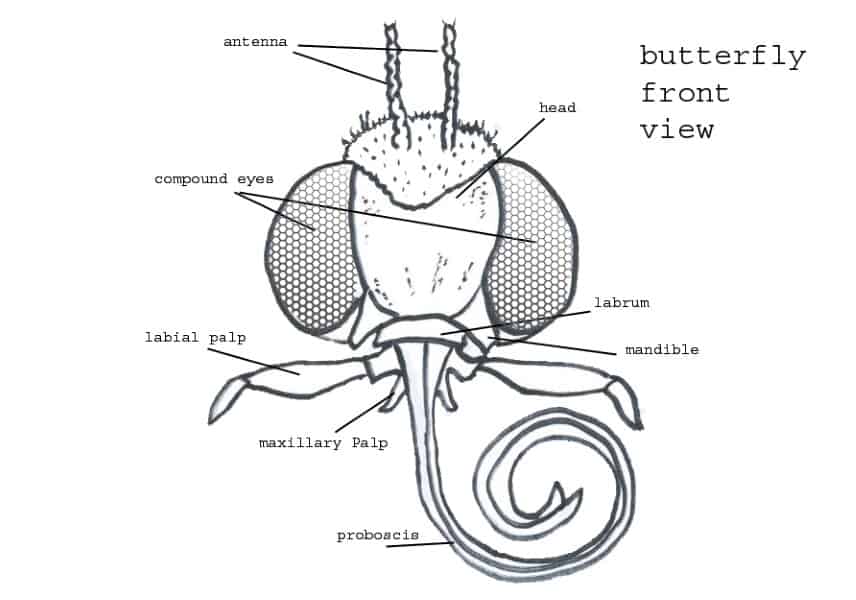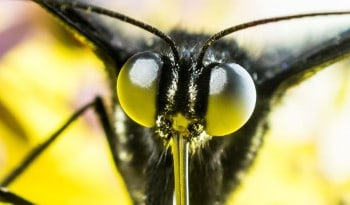An interesting question, in fact, you might think it an easy answer – being two eyes?! But we know that many insects have different types of eyes and in some cases multifaceted eyes.
In fact, butterflies are known to have the widest range of vision of all wildlife. They have a larger visual field than humans and excellent visual perception of fast-moving objects.
Impressive right? So let’s start with the quick answer, and then we’ll dive into a bit more detail…
How many eyes do butterflies have? Butterflies have two different types of eyes. Both single, and 12000 compound eyes. The single-chambered eyes focus mainly on individual objects. Whereas their 12000 compound eyes are used as their main eyesight. They can see light wavelengths from 254 to 600 nm, which includes ultraviolet light.
But does this apply to all butterflies? And if not then what are the exceptions? And more importantly, how are we going to relate to having two separate sets of eyes that do different things? Well, let’s explore it a bit more…
Compound Eyes in Butterflies
What are they? Well, let’s clarify this first. In the shortest explanation, compound eyes are a multifaceted array of different eyes. Each with its own imaging ability. Collectively they can form a wider picture in which the scope covers almost 360 degrees of vision, aside from the blind spot created by their own bodies.
These compound eyes in butterflies are responsible for providing their all-round vision. They have four classes of receptors which are responsible for their wide visual range. These eyes are also used for sensing ultraviolet color and polarized light.

Butterfly Ultraviolet Vision
Butterflies compound eyes are stained to see light wavelengths from 254 to 600 nm, this range includes ultraviolet light which humans are unable to see, as our vision extends from 450 to 700 nm.
Butterfly Flicker Fusion Rate
A bit like the ‘frame rate’ you might see on your video camera or TV screen. This is the rate at which images flicker across the eye to create a continued vision.
To give you some context, a humans flicker-fusion rate is 45-53 flickers per second. However, a butterflies flicker/fusion rate is 250 times greater than that of humans. Giving them an excellent continually updated image.
Add in ultraviolet range chart and flicker rate chart or YouTube vid.
What Are Butterflies’ Single Eyes For?
The single-chambered eyes in butterflies are more like human eyes in the way they function. They’re used to discern and focus in on individual objects and near and far range.
Combined with other senses the eyes offer a great advantage for butterflies. Their eyes are delicate yet highly functional.
Light and Butterfly Eyesight
Butterflies use ultraviolet light to search out food, identify predators and for searching for a suitable mate. They also use it for recognizing nectar.
For example, when a horse chestnut tree stops producing nectar, it’s color range will change from yellow to red. The fifteen types of photoreceptors will be used to detect these various color ranges.
Butterfly Markings, Eyesight, and Ultraviolet Color
To humans, the markings on a butterfly are both colorful and beautiful. To a butterfly, however, these colors denote ultraviolet markings which identify different species.
Not only that, but the difference in markings between a male and a female become equally important in identifying a potential mate within a species through those ultraviolet markers.
Butterflies With Exceptional Vision
So do all butterflies have this ability? What are the exceptions in butterfly eyesight?
The Monarch Butterfly Eyesight
Among many amazing facts about the monarch butterfly, their compound eyes contain 12000 individual visual cells able to capture a high rate of flicker-fusion per second.
Australian Swallowtail Butterfly
The Australian swallowtail butterfly puts all the rest in the shade. Rather than the usual 4 classes of receptors used for wide vision, the Australian swallowtail possesses an amazing fifteen varieties of photoreceptors. These are used to full effect in identifying ultraviolet color markings for mating and pollination purposes.

The Australian swallowtail butterfly puts all the rest in the shade. Rather than the usual 4 classes of receptors used for wide vision, the Australian swallowtail possesses an amazing fifteen varieties of photoreceptors. These are used to full effect in identifying ultraviolet color markings for mating and pollination purposes.
To Finish
Despite using other senses, butterflies rely heavily on eyesight to find their way around their world. With such good eyesight who would blame them.
This eyesight is possibly attributable to the thriving population of this species throughout the globe, with some 17,500 recorded varieties.
